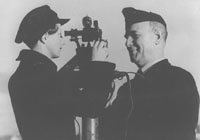


War History of the Australian Meteorological Service
Foreword
Preface
Introduction
Chapter 1: D.Met.S.—Australia's Wartime Weather Service
Establishment of D.Met.S. War Communication System
New Stations and Services
Censorship and Codes
RAAF Appointments
Organisational Conferences
Pacific Island Weather Stations
Services to the War Room
The Allied Air Meteorological Service
Training of US Personnel
Perth-Colombo Air-route
Wide Pacific Expansion
Closing Years of the War
Chapter 2: The Weather Factor in Warfare
Chapter 3: Met in the Retreat
Chapter 4: Met in the Advance
Chapter 5: Meteorology in Aviation
Chapter 6: Central Forecasting Services
Chapter 7: Met With the Army
Chapter 8: Research and Personnel Training
Chapter 9: Instrumental Development and Maintenance
Chapter 10: Scientific Developments in the RAAF Meteorological Service
Chapter 11: Divisional Bureaux and Their Work
Appendix 1: List of Reports Provided by D.Met.S. for Advances Operational Planning and Other Purposes
Appendix 2: List of Service Personnel RAAF Meteorological Service
Appendix 3: List of Civilian Personnel Who Worked Together with Service Personnel of the RAAF Meteorological Service
Appendix 4: List of Locations at which RAAF Meteorological Service Personnel Served
Index
Search
Help
Contact us

In peace, weather science serves the farmer, the manufacturer, the builder, the traveller on all the highways of commerce. In a thousand avenues of development it can, effectively applied, serve the national need for weather information. In war its effective application has become more complex and general with every great conflict since the dawn of history. The long struggle recently ended involved the widest area of operations yet required of the meteorologists of all nations and brought about technical advances in meteorological practice which will be reflected increasingly in the peacetime weather services to the nations.
Establishment of D.Met.S. War Communication System
Australia's wartime meteorological organisation was developed rapidly from a long established civil system, a task helped considerably by a fundamental reorganisation which had taken place under the direction of Mr H. N. Warren, a Public Service Inspector, shortly before hostilities commenced, as part of a general plan for expansion to meet the expanding needs of civil aviation. In July 1939, when war with Germany appeared imminent, a conference was arranged between representatives of the Navy, Army and Air Force and executives of the meteorological service led by Mr Warren, then its Assistant Director of Administration. The conference discussed in broad outline the meteorological requirements of the fighting services in modern war and decided to recommend to the Federal Cabinet that in the event of war, civil administration of the meteorological service should be transferred to the Minister for Air and that the operational organisation should be organised as a service formation of the RAAF in a Directorate of the Royal Australian Air Force.This recommendation was approved by Cabinet and when war against Germany was declared on 3 September 1939 action was taken to implement the decision.
Transfer of the organisation from the control of the Department of Interior to that of the Minister for Air did not take place finally until 30 June 1940, but in the intervening period action had been taken by Mr Warren (now acting Director) to extend the scope of the meteorological service and to prepare for the great task ahead. Provision was made for a research unit to undertake immediate and continuous development of the modern techniques of air-mass and frontal analysis in the Australian region, together with general developmental work on meteorological conditions on air-routes and in probable operational areas. At the same time production of text books and meteorological studies in the war interest were planned to a defined programme, whilst in the laboratory and workshop, expansion was carried out to prepare for the anticipated great increase in maintenance and repair work.

As the nucleus of an expanded wartime forecasting staff, which subsequently was to stretch over the whole South-West Pacific area, science masters were recruited from certain State education departments for the duration of the war, and trained in weather analysis, with particular emphasis on operational aspects. These were subsequently appointed as weather officers and formed the backbone of the greatly expanded war organisation.
People in Bright Sparcs - Warren, Herbert Norman
 |
Bureau of Meteorology |  |
© Online Edition Australian Science and Technology Heritage Centre and Bureau of Meteorology 2001
Published by Australian Science and Technology Heritage Centre, using the Web Academic Resource Publisher
http://www.austehc.unimelb.edu.au/fam/0627.html